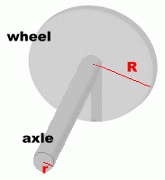 The wheel & axle can be used as a tool to multiply the force you apply, or to multiply the distance travelled. Here's how it works ...
The wheel & axle can be used as a tool to multiply the force you apply, or to multiply the distance travelled. Here's how it works ... You apply a force on the wheel, whose radius R is larger than the axle. The force is transmitted to the axle, which has radius r. This resultant force, which is bigger than the force you applied, does some work for you. The force that does the work is bigger by a factor of R/r For example, the wheel is 10 times wider than the axle; the resultant force is 10 times bigger. Wheel and axle machines of this form are very common ...
A wheel & axle can also be used in reverse. You apply force to the axle, to make the wheel turn. This doesn't seem to make much sense ... you'll have to apply a much larger force, to produce a relatively small resultant force. Why bother? There are two reasons why you would want to do this. First, like all simple machines, there is a trade-off. In a normal wheel & axle like those above, when the force is multiplied by, say, a factor of 10, the axle turns through a circular distance of only a tenth of that through which you turned the wheel. This isn't a problem turning a screw with a screwdriver, because the circumference of the hole is small. However, let's reverse the situation. Suppose you apply your force to the axle. like on a vehicle. If you turn the axle, the wheel will turn through a distance 10 times as much as you turned the axle. As the wheel is attached to a vehicle, each turn of the wheel moves you farther along the ground. With a really big wheel, one tiny turn of the axle moves you down the road a distance equal to the much larger circumference of the wheel. As with other devices, you will have to provide a large force to multiply the distance. This relates to the second reason why we would want to apply our force to the axle, even though we don't get much resultant force from the wheel. If we have a large source of power to apply to the axle, we don't care how much force is needed! This is the principle behind the reverse wheel & axle. You apply whatever force you need to the axle, from some sort of motor, and the resultant force given off by the wheel, although much smaller, will cause the wheel to turn through a very large distance. 

 |
